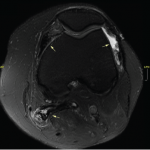BOSTON—Research on two members of the immunoglobulin superfamily of proteins, CTLA-4 and PD-1, may one day generate novel, targeted therapies for autoimmune rheumatic diseases, such as rheumatoid arthritis (RA) and systemic lupus erythematosus (SLE).
These signaling pathways each play significant roles in the process of autoimmunity, said Vassiliki A. Boussiotis, MD, PhD, professor of medicine at Harvard Medical School and Beth Israel Deaconess Medical Center. At the lecture, Co-Stimulation Pathways: Therapeutic Opportunities for the Rheumatic Diseases, held Nov. 19, 2014, at the ACR/ARHP Annual Meeting in Boston, Dr. Boussiotis discussed how stimulatory and inhibitory pathways may help regulate T cell responses. Developing agents to manipulate these co-stimulation pathways may help rheumatologists block the destructive effects of autoimmunity on organs and tissues.
Prevent Destruction
T cells play essential roles as orchestrators or effectors of the immune system, she said. “One of the most important properties of the immune system is its ability to recognize foreign antigens and respond to those foreign antigens while preventing destructive immune responses against autologous tissues in the host.” In autoimmunity, this control or delicate balance is lost, and the result is injuries to vital organs and tissues that one sees in such diseases as RA and lupus.
During thymic selection, the majority of self-reactive T cells are eliminated via a process called central tolerance, Dr. Boussiotis said. However, a fraction of these cells may escape and retain the potential to inflict destructive autoimmune pathology against their host. The immune system has other mechanisms to prevent such attacks of escaping cells, chiefly induction of peripheral tolerance. This is a complex network of stimulatory and inhibitory receptors and ligands, and they send cell-to-cell signals that dictate the outcome of T cell encounters with the cognate antigen, she said.

T-regulatory cells, which exert cell-extrinsic control over these autoreactive T cells, also play an important role in this process. “Cell-extrinsic mechanisms, which mostly depend on the presence of regulatory cells, use many of these cognate ligands and their receptors in order to mediate these cell-extrinsic suppression functions to the T cells,” said Dr. Boussiotis.
Two important receptors, cytotoxic T-lymphocyte protein 4 (CTLA-4) and programmed cell death protein 1 (PD-1), are both involved in peripheral tolerance. Blocking agents to these molecules are being developed as anticancer therapies. These two proteins’ unique molecular structures, the expression patterns of their receptors and ligands, and their mechanisms of cell-intrinsic and cell-extrinsic activity make their therapeutic potential in rheumatic diseases intriguing, she said.

